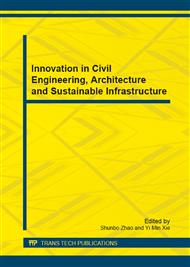[1]
V. T. Giner, F. J. Baeza, E. Zornoza, B. Ferrer, Silica fume admixture effect on the dynamic properties of concrete, Construction and Building Materials, 25 (2011) 3272-3277.
DOI: 10.1016/j.conbuildmat.2011.03.014
Google Scholar
[2]
J. Xie, A. E. Elwi, J. G. MacGregor, Mechanical properties of three high-strength concretes containing silica fume, ACI Materials Journal, 92 (1995) 135-143.
DOI: 10.14359/9764
Google Scholar
[3]
S. Bhanjaa, B. Sengupta, Influence of silica fume on the tensile strength of concrete, Cement and Concrete Research, 35 (2005) 743-747.
DOI: 10.1016/j.cemconres.2004.05.024
Google Scholar
[4]
S. Bhanjaa, B. Sengupta, Investigations on the compressive strength of silica fume concrete using statistical methods, Cement and Concrete Research, 32 (2002) 1391-1394.
DOI: 10.1016/s0008-8846(02)00787-1
Google Scholar
[5]
S. Bhanjaa, B. Sengupta, Modified water-cement ratio law for silica fume concretes, Cement and Concrete Research, 33 (2003) 447-450.
DOI: 10.1016/s0008-8846(02)00977-8
Google Scholar
[6]
P. Zhang, Q. Li, H. Zhang, Combined effect of polypropylene fiber and silica fume on mechanical properties of concrete composite containing fly ash, Journal of Reinforced Plastics and Composites, 30 (2011) 1851-1860.
DOI: 10.1177/0731684411425974
Google Scholar
[7]
P. Zhang, Q. Li, Z. Sun, Influence of silica fume and polypropylene fiber on fracture properties of concrete composite containing fly ash, Journal of Reinforced Plastics and Composites, 30 (2011) 1977-1988.
DOI: 10.1177/0731684411431358
Google Scholar
[8]
P. Zhang, Q. Li, Z. Sun, Effect of polypropylene fibre on flexural properties of concrete composites containing fly ash and silica fume, Proc. Inst. Mech. Eng. Part L, Journal of Materials Research Applications, 226 (2012) 177-181.
DOI: 10.1177/1464420712437637
Google Scholar
[9]
JTJ E30-2005, Test methods of cement and concrete for highway engineering test methods of materials stabilized with inorganic binders for highway engineering, China Communications Press, China, 2005.
Google Scholar
[10]
ASTM C666 1997, Standard test method for resistance of concrete to rapid freezing and thawing, Annual Book of ASTM Standards, 04.02: 310-315, 1997.
Google Scholar
[11]
ASTM C215 1997, Test method for fundamental transverse, longitudinal, and torsional frequency of concrete specimens, Annual Book of ASTM Standards, 2 (1997) 119-124.
Google Scholar


